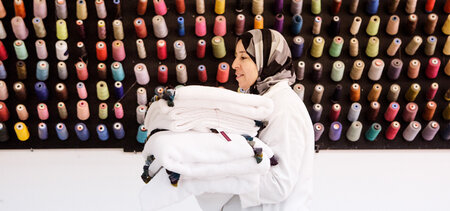Tamegroute Pottery, 1000 shades of green
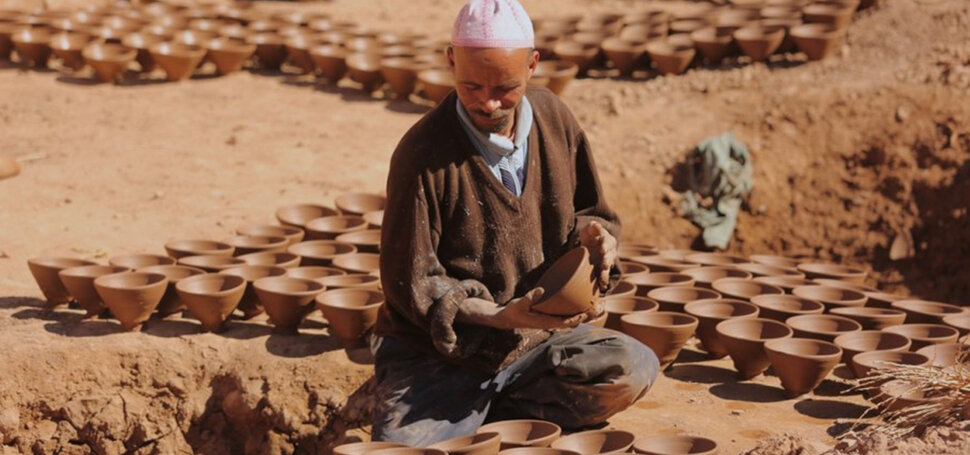
Pottery and ceramics are considered an ancient tradition in Morocco which fill the souks with colourful designs. In particular, the beautiful green examples of Tamegroute are a pleasure for the eye to behold. Sturdy yet refined with small distinguishing imperfections which make each piece unique. Intrigued by the artisan production process, we ask Conny Hofmans (an amateur photographer and fan of Morocco) to go on a journey for us. Embarking on a trip to find the story behind the platters, plates, bowls and carafes that adorn our shop.
Tamegroute, last place before the desert
Tamegroute lies in South Morocco, just before the immense Sahara. In the Berber language, Tamegroute means ‘last place before the desert’. The town arose in the 6th century and is one of the oldest towns in Morocco. It was the last stop for the well-known trade caravans who travelled across the desert to Timbuktu with their camels.


7 ovens and 7 potters’ families
The town is not difficult to find: plumes of smoke, originating from the ovens, direct the way to the square where the ateliers are situated. The winter sun sheds a warm glow over the square. Men are busy moving about and the baking of the pottery is in full swing.
Within the square, you find 7 ovens, 7 ovens belonging to 7 pottery families. Each family has 1 oven and their own atelier built of clay. Every family member has his or her own task and specialty. The art-form and ability of pottery is carried over between generations.


From clay to a unique piece of pottery
The entire production process exists out of several steps which are each carried out very carefully.
Hunks of clay are dug out of the Draa riverbed and brought in carts to the turn-ateliers. In front of each atelier is a pit where the clay is mixed with water. Next, the clay is stretched out on the ground to let the moisture evaporate. An experienced potter knows precisely when the clay is ready to knead.
When the clay is perfect, the potter starts to spin. In every atelier, a hole has been dug out where the potter sits in up to his waist. Hour long sessions at the wheel follow. Hunk after hunk is kneaded and tamed. The humming of the pottery wheels continues on for hours. The clay melts in the hands of the masters and is slowly formed into bowls, cups, vases…

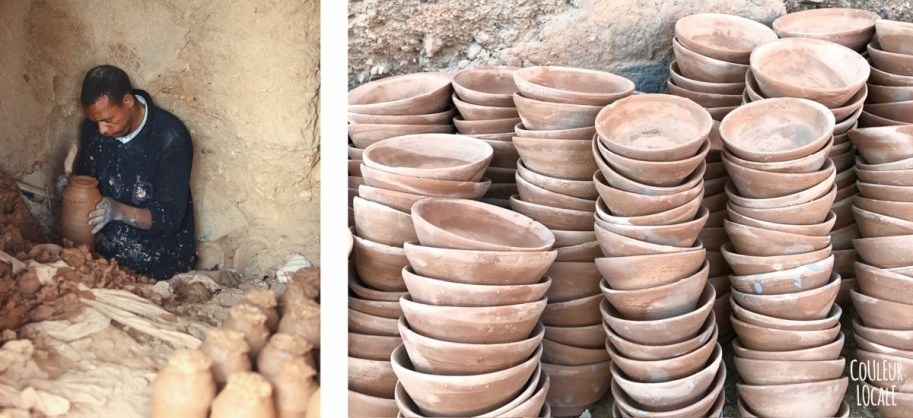
Afterwards the pottery is stored inside for 24 hours where it is then placed outside to dry further. In the winter this process takes far longer than in the heat of the summer.
During this time the potter will make small corrections to the shape while the clay is still somewhat moist and fictile.


A special green colour
Since Tamegroute pottery is only baked a single time, the glaze is painted before it enters the oven. The glaze consists of 80% manganese, 19% silicon and 1% copper. The 1% copper together with the clay out of the Draa river-bed is exactly what forms the characteristic green colour. Another type of clay with the same glaze composition would still not provide the same result. In some cases, the copper is replaced with iron oxide to produce more of a brown/olive coloured result.
Every pottery piece is submerged by hand and then dried in the sun. The glaze now has a matt blue-grey colour. Only after being baked at high temperatures in the oven will it change to the typical green colour.
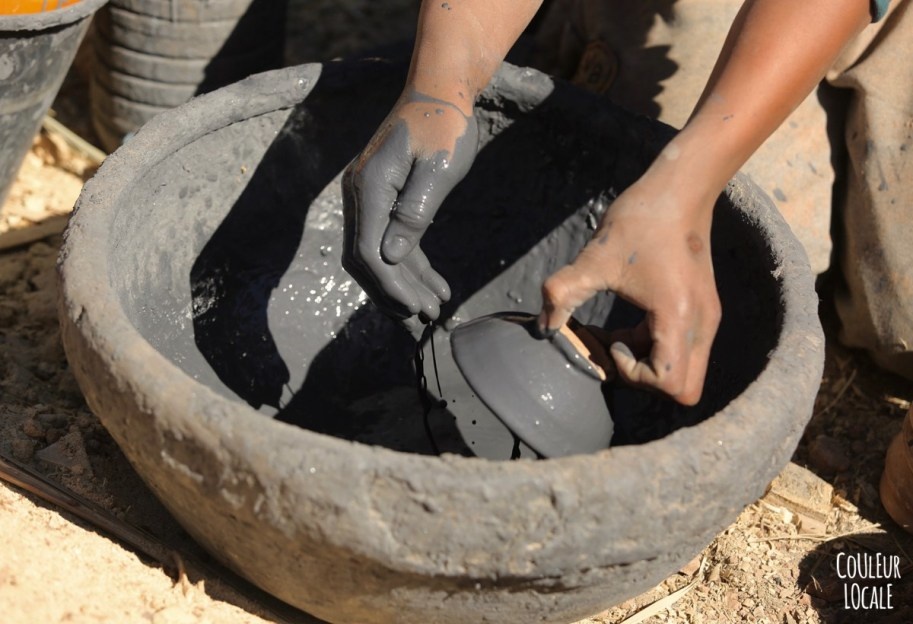

Baking at high temperatures
Meanwhile, the ovens are being prepared. Palm branches, wood shavings, and sawdust are collected. Triangular pieces of clay are used for the separation between different pieces of pottery. When the oven is completely full it is then sealed up hermetically with clay. The fire causes the temperature to rise at a slow rate. This is very important to allow the moisture inside the clay to evaporate slowly. On top of the oven a man closely watches over the entire process. He is able to influence the temperature by controlling and closing several smoke passageways. When the green colour is easily visible the wood shavings are added causing the temperature to rise further. The oven reaches a maximum temperature of 1200 degrees Celsius. A rule amongst potters says that the higher the temperature, the more durable the pottery will be.
When the items inside are well baked, the oven is put out slowly bit by bit. In the meantime, the baking process continues. 24 hours later the fire continues to smoulder and the oven remains warm. Once everything has cooled down enough the oven will be broken open.




Craftsmanship
The entire process is based on pure craftsmanship. Everything is done through feeling, one that is based on years of experience passed on from father to son for generations. Not a single measuring device or thermometer is ever used.
Every piece is unique
A Tamegroute pottery piece is completely unique. The colour and shape is never exactly the same. Nowhere else on earth will you find the same result. The very spot in the oven, the exact composition of the glaze, the heat of the oven, the technique of the potter, the manner of piling … they are all elements which factor different results.
Tamegroute pottery are true showpieces within the interior of a house. Simple, practical, decorative and made for daily use! All of that colourful beauty makes us so happy!
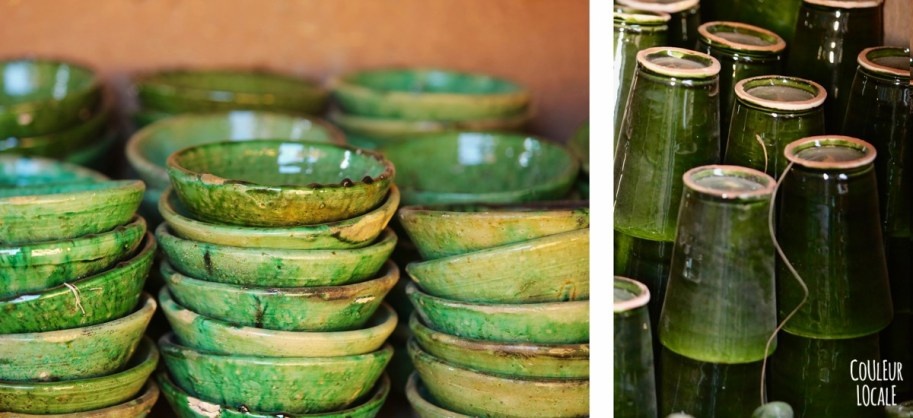

Images Tamegroute © Conny Hofmans for Couleur Locale – Last Foto © Couleur Locale/Jeltje Janmaat



